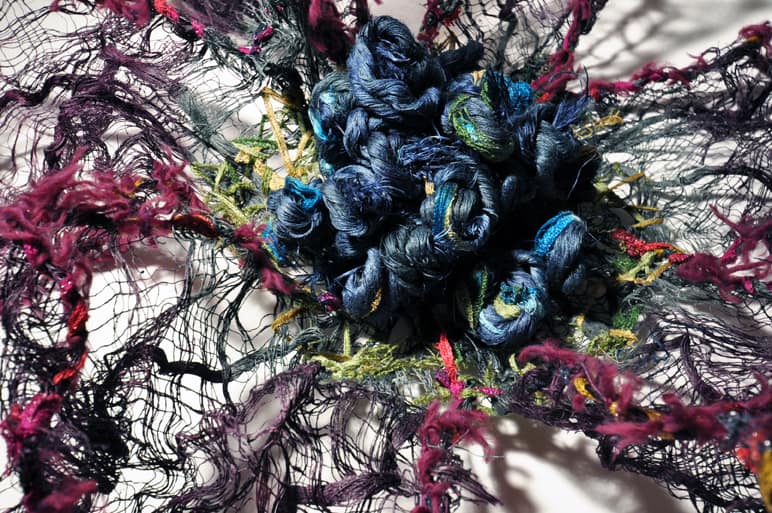
Nnenna Okore with “Sheer Audacity,” 2016, Burlap, Installation view.
Courtesy Memphis Brooks Museum of Art.
Born in Australia, raised in Nigeria and currently based in Chicago, artist Nnenna Okore has exhibited her multimedia works widely around the globe. Through September 10, 2017, the Memphis Brooks Museum of Art’s 70-foot-tall rotunda is filled with Okore’s suspended burlap installation, Sheer Audacity. Okore fuses metaphorical content with labor-intensive processes and tactile material, and over the course of her career, her works have spanned topics from recycling and consumerism to the inescapable cycles of nature and life.
“Osimili,” Okore’s upcoming solo exhibition at San Francisco’s Jenkins Johnson Gallery (June 1 – July 15, 2017), also incorporates burlap material in wall-bound works resembling wild, overgrown flora. Okore spoke with art ltd. about this new series, her role as a mentor and chair of the art department at North Park University, and the common threads that wind through the varied works in her oeuvre.
art ltd: Tactile material is such a crucial part of your practice. How do you go about choosing your materials and conceptualizing a project like Sheer Audacity?
Nnenna Okore: I wanted have something that was gossamer in its quality, something that was sheer, thready. I knew right away that I was going to be using the burlap, which I had already experimented with to know that it is possible to achieve these kinds of qualities.
Apart from that, I was so thrilled by the scale. I love the challenge of filling up or transforming a space. The building is peculiar in that it has a place where you can view from above and below. I was thinking about engaging the space in an experiential way, so that you can actually stand at the top, look down, and feel the enormity of how the work is dipping. Or experience how the series of fibers are entwining, creating this view from up above that is different from how it is viewed from below.
Courtesy: Jenkins Johnson Gallery
AL: Your exhibition, “Osimili” opens at Jenkins Johnson in just a few days. What kinds of themes inform this new series?
NO: I’ve used references to nature and Igbo words (my ethnic language) to describe the ideologies of the flow of life. Osimili is not directly translatable, but metaphorically it means a big body of water, something that is fluid. I have been fixated in recent times with the phenomena of life: the essence, the enigma, the fluidity. I’ve been drawn to a particular image, the floral, because that is such a strong visual example of a fleeting experience. They’re never there forever. They change and grow, and expire and die. They rejuvenate the earth and then new things come up.
In Africa, you see it in the cosmological way of defining life: there is birth, boyhood, manhood, death, and there is the spirit world, which then comes back through incarnation into birth. I’ve grown up around these philosophies of reincarnation, and it tends to be inherent in my work. Only now am I realizing that this is what is driving me.
Courtesy of Jenkins Johnson Gallery
AL: Nature wasn’t always the key metaphor in your works. How did you arrive at the concepts and materials that you use today?
NO: In graduate school, my focus was recycling. I had started recycling in Nigeria, but I was copying what people do as a cultural form of recycling. They would use paper to cover the table or to preserve food. They would reuse plastic bottles to store other kinds of liquids or substances. But, when I came to the States, I saw the abundance of materials everywhere, like phone books piled in doorways, for example. There is a sense that there isn’t attention to using something until it is completely exhausted. It took me in a different direction, exploring ideas of consumerism and how that translated to how people discard things.
Eventually, I started thinking about how my material, like paper, was starting to break down over time. That lead me into a different space, to exploring ephemerality of the material itself. From there I found myself moving towards the reference to life in general.
AL: You’ve stated that working with young artists is an important part of what you do. How has being a mentor and an educator impacted your career?
NO: As an educator, you want to challenge your students, you want them to understand that art is a way of life. So, when you are making your art, you need to be thinking about how it relates to you, and your own experiences, which is also how I process art. I teach my students through my own lenses. As a teacher, I think it’s a give and take: you are helping your students understand concepts, theories or practices, but at the same time you are very keen on picking up from them how to perceive things in a fresh new way.
When I mentor, I want young female artists to understand that nothing is impossible for them. There were many male artists practicing in the communities I grew up in that one could look up to, but not many female artists. It struck me because I thought that maybe there was something wrong with a woman being an artist. The societal stigmas around scratching out your living as an artist can be discouraging, but it does help to give courage to women. I especially try to get them to go to grad school, to get their portfolio together, to think about articulating ideas in a compelling way.


